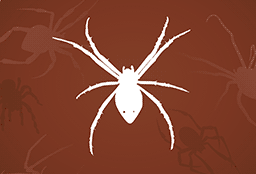Tiny, plain grey-brown and whitish wader with black legs and straight, gently tapering black bill, slightly swollen at tip. Shadowy dark line from bill through eye separates small white area over bill and subtle whitish eyebrow from whitish throat. Upperparts are grey-brown. Underparts are whitish with grey-brown zone on sides of upperbreast.
Size
13 – 16 cm
Stocky, medium-sized migratory shorebird with a short black bill and short orange legs. Back, head and upper chest is marked with black-brown and pale areas (tortoise shell-like) with a white breast. The bill is wedge-shaped and slightly up-tilted. In flight, there is a distinctive black and white pattern.
Distinctive features
The distinctive marking and dark and white pattern in flight make the Ruddy Turnstone unmistakeable, along with their habitat of turning over stones.
This spider is named for the cross the female weaves into the web. There are many theories about why the female does this including, strengthening the web, for camouflage, and for increasing prey catches as the cross reflects ultra-violet light which attracts insects. It may also deter predators which must go to the effort of cleaning off the extra silk after diving into the web.
The female has a silvery head with silver, yellow, red and black bands across its abdomen, and two yellow stripes running down its underside. Its legs are dark brown to black with one or two yellowish bands. The male and juveniles are brown and cream, with brown legs. It often appears to have only four legs because it sits with its legs in pairs along the stabilimentum.
Distinctive feature
The zigzag patterns (known as the stabilimentum) it weaves into its web to form an X or a cross, after which it is named.
Mostly light blue-grey in colour. The forehead, crown, chin and upper throat are white. It has a long, slim neck and a pointed grey-black bill. The legs are long and dull yellow in colour. Easily identifiable when seen from below with the dark flight feathers of the wing contrasting with the paler grey plumage.
Males and females are similar. When breeding, the birds have long feathers (nuptial plumes) on the head, neck and back. Young are similar in appearance to non-breeding adults, with little to no white on the face; underparts often have a reddish colour.
Distinctive feature
Its characteristic white face.
One of Australia's most widespread birds on mainland.Mostly black with a white belly and eyebrow. A young bird has paler, slightly rusty edges to its wing feathers.
Size
18 - 22 cm long (from head to tail)
Fast growing deciduous tree that grows to 15 - 25 m tall.
Leaves
Long strips of small leaves 30 - 60 cm long.
Flowers
Bright yellow flowers with orange stamens that blossom from March to June and September to November.



